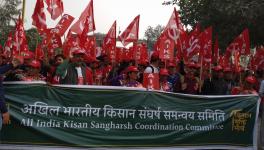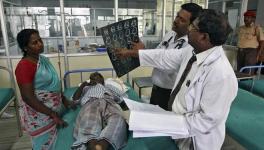Karnataka’s Expenditure on Education and Health is Shockingly Low

July 5, 2018, was the day that the people of the State of Karnataka were waiting for. The newly formed JD(S) and Congress coalition government led by the Chief Minister H D Kumaraswamy announced the state budget for the fiscal year 2018-2019. This state budget was announced with the dramatic event of the state assembly election leading to the formation of the current government in the backdrop. The JD(S) which H D Kumaraswamy represents in the assembly, in its election manifesto had promised a full farm loan waiver for the farmers. The party had promised to waive off “all agricultural loans including crop loans, horticulture loans, and medium-term loans availed by the farmers of Karnataka” on a one-time basis. Standing by the party’s promise (though not in one-time basis) the CM in Phase I of the loan waiver scheme has waivedall defaulted crop loans of the farmers made up to December 31, 2017.
But since then, the much talked about farm loan waiver scheme has seen the light of the day. The manifesto, however, speaks about various social sectors. Karnataka had in total had allocated 40.8 percent of its total budget on social sectors in 2016-2017 while the all-state average was 42.8 percent. The allocation for the agriculture, which is the voting base for the JD(S), some argue is the “populist” scheme to retain this voting base of the party. What are the allocations for other sectors in the current budget? The allocations made for the education, medical and public health sectors, for example, raises questions about the possibility of fulfilment of promises made for these sectors. In both the sectors, as discussed further, the data show a decline or a stagnation in the state’s funding over the years.
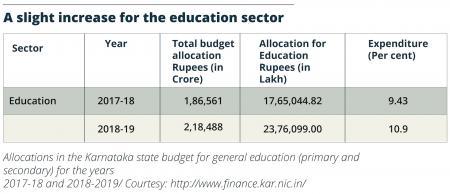
Table 1 shows the allocations made in the budgets of the previous year and of the current year for the general education (primary and secondary schools) sector. Out of Rs 2 lakh crores (two trillion) the total budget, twenty-three lakhs has been allocated for the general education. Which amounts to 10.9 percent of the total budget. The allocation has slightly increased from 9.43 percent in the previous year budget, which was seventeen lakh out of one lakh crore.
Even though as compared to the previous year’s allocation it is higher, the data shows that the expenditure in the education sector by the state of Karnataka is gradually decreasing. It was 17.7 percent for the year 2000-2001, and ever since has been decreasing. The allocations made for the year 2000-2001 was almost the same as the average allocation for education in all states - which was 17.4 percent. In the fiscal year of 2016-2017, the all-state average allocationwas 15.6 percent and the state had allocated 12.7 percent. As shown in table 1. the allocation saw a decrease in the following year.
The dropout rate of students in the government school is increasing and most of the schools in the state are not being cared for. Bad infrastructure and other facilities plague the government schools in the state. The government in the current budget has announced a special package of Rs 150 Crore for repairs of government primary, high school (77,552) and Pre-University colleges (5,235); it also has proposed installation of biometric instruments in forty-eight thousand schools in three years to check the attendance.
With the ever-growing problems of schools in the state, the trend of allocations made in the budget over the years seems to be moving towards negligence. In the year 2012-2013, the Education Development Index (EDI) of the state was 0.661 and stood fifth, which was a downfall from a much higher EDI the state had shown the previous years. This alarming depletion in the education should have had higher allocation, but as seen is one of the least in last five years.
The other sector which bears a stark decline in the allocations is the Medical and Public Health sector.
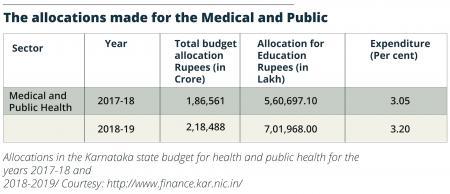
The state government in 2017 strived towards amending the Karnataka Private Medical Establishments (KPME) Act of 2007 standing against the schemes supporting the private health sector. The government’s move following this took a different turn wherein the reports have shown, the private players are having the upper hand in the health sector in the state. A cursory look at the allocations made for the sector forces one to observe the state's health sector moving towards privatisation.
Table 2 shows the allocations made in the budgets of the previous year and of the current year for the Medical and Public Health sector. Out of Rs two lakh crores ( two trillion ) the total budget, seven lakhs has been allocated for the sector. Which amounts to 3.20 percent of the total budget. The allocation for the sector has slightly increased from 3.05 percent in the previous year budget, which was five lakh out of one lakh crore.
As in the case of the Education sector, the allocation for the Medical and Public Health sector has declined over the years. In the year 2016-2017 the state had allocated 4.1 percent of the total budget for the sector; as seen in Table 2 there is a sharp decline the following year. The data shows the decline since 2001. For the year 2000-2001 the allocation in the state budget was 5.1 percent higher than the all-state averageexpenditure for Medical and Public Health, which was 4.6 percent. One can see that the state’s allocation has usually been at par the all-state average expenditure in the health sector. However, this has changed now. For the year 2016-2017, the all-state average expenditure was 4.9 percent and for the 2017-2018 and the state allocated 3.5 percent.
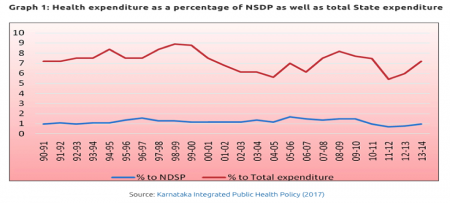
The state is recorded to be doing good in its health sector. Karnataka is one of the first Indian states to put a state health policy in place (2004). It has also been a pioneer in government supported health insurance schemes, with Yashaswini (2002) and Vajpayee Aarogyasri (2010) among the first initiatives in India. However in the graph above Karnataka Integrated Public Health Policy(2017), shows the stagnation in the state expenditure on public health. According to the Karnataka government’s data in the Economic Survey of Karnataka (2017-18), the stagnation in funds has adversely affected the functioning of the public health facilities.

Number of hospital is in rise but beds per lakh population has touched the rock bottom of 80 in 2016-2017 from 112 in 2010-2011; the number of dispensaries are also on the decline. Against this backdrop, the current budget of the government has to answer many questions. The state government has been under constant attack for letting the private players in the health sector influence policies. The yet again low end allocation in the budget shows where the sector in the state is heading towards.
The Karnataka state budget, which is being celebrated for waving off the farm loans, neglects the education and health sector. The state, as explained here has been performing not very well in these two sectors; with its low records in the indices in these sectors the current allotment shows no hope this year.
Get the latest reports & analysis with people's perspective on Protests, movements & deep analytical videos, discussions of the current affairs in your Telegram app. Subscribe to NewsClick's Telegram channel & get Real-Time updates on stories, as they get published on our website.















